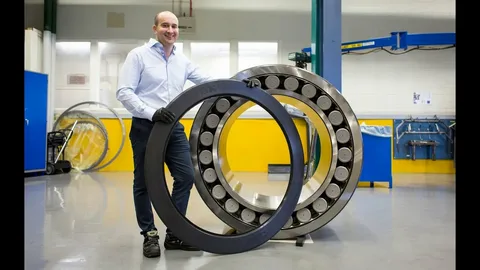SKF thrust bearings set the standard for handling axial forces with exceptional precision and durability. For engineers and maintenance teams, mastering skf thrust bearing selection and understanding thrust bearing types is essential to ensure machinery reliability. This guide covers design features, load calculations, installation tips, and maintenance strategies for peak performance.
The Hallmarks of SKF Thrust Bearing Engineering
SKF thrust bearings combine innovative design and premium materials to meet rigorous industrial demands.
- High-Grade Materials: Hardened steel rings paired with advanced polymer cages.
- Optimized Cage Construction: Reinforced PA66 cages for roller stability.
- Tailored Solutions: SKF’s digital selection tools for perfect fitment.
- Reduced Energy Loss: Low-friction profiles lower operating costs.
- Certification Standards: Compliant with ISO/TS 16949 for top-quality assurance.
Exploring SKF Thrust Bearing Varieties
Thrust Ball Bearings
- Available in single- and double-direction formats.
- Suited to moderate axial loads at high rotational speeds.
- Found in automotive clutches and precision motors.
- Offered open, shielded, or sealed to fit application needs.
- Easily disassembled for maintenance.
SKF Thrust Ball Bearing
- Superior dynamic load ratings for heavy-duty use.
- Universal cage design for versatile mounting.
- Bore diameters range from 20 mm to 120 mm.
- Max speeds up to 6,300 rpm.
- Operational temperatures up to 120 °C.
Cylindrical Roller Thrust Bearings
- Exceptional axial capacity with low rolling resistance.
- Durable reinforced cages.
- Compact footprint perfect for tight assemblies.
- Ideal for presses, gearboxes, and ventilation fans.
- Not for radial load support.
Spherical Roller Thrust Bearings
- Self-aligning rollers accommodate shaft misalignment.
- Handles axial plus moderate radial forces.
- Designed for mining, construction, and marine applications.
- Asymmetric roller geometry for uniform load spread.
- Available in maintenance-free variants.
SKF Banded Thrust Bearings
- Rollers secured by banded assemblies to prevent displacement.
- Built for heavy-impact axial duty.
- Simplified fitting in vertical shaft setups.
- Robust under fluctuating operational loads.
- Long service intervals in extreme environments.
Calculating Load Capacities and Axial Performance
- Dynamic Rating (C): Load for a rating life of one million revolutions.
- Static Rating (C₀): Load before permanent deformation.
- Sizing Example: Required axial force 25 kN with 1.2 safety factor → choose C ≥ 30 kN.
- Speed Adjustments: Account for lubrication and thermal effects.
- Combined Load Solutions: Opt for spherical roller thrust types when slight radial forces exist.
- SKF’s Online Tools: Precise calculators simplify selection.
Tailoring Bearing Choice to Industry Applications
- Heavy Equipment: Cylindrical roller thrust bearings in industrial presses.
- Mining Operations: Spherical roller thrust bearings resist dust and alignment shifts.
- Construction Machinery: Needle thrust bearings absorb shock loads in hydraulics.
- Wind Energy: Large spherical roller thrust bearings endure extreme weather loads.
- Marine Drives: Sealed thrust ball bearings protect against saltwater corrosion.
Installation Best Practices for Peak Reliability
- Clean Assembly Area: Avoid contaminant ingress.
- Precision Alignment: Use dial gauges to verify washer parallelism.
- Correct Lubrication: Follow SKF’s lubricant recommendations for your speed and temp.
- Accurate Preload: Adjust axial clearance to minimize vibration.
- Torque Compliance: Adhere to SKF’s torque specs when tightening locknuts.
Maintenance Protocols for Harsh Environments
- Regular Checks: Track temperature and vibration in dusty settings.
- Effective Sealing: Labyrinth or rubber seals keep out sand.
- Frequent Relubrication: Shorten intervals in high-heat or contaminated conditions.
- Rust Prevention: Apply coatings on exposed surfaces.
- Condition Monitoring: Use sensors for proactive maintenance.
How SKF Bearings Outperform Alternatives
| Aspect | SKF Thrust Bearings | Competitor A | Competitor B |
| Maximum Axial Capacity | Up to 500 kN | Up to 450 kN | Up to 480 kN |
| Self-Alignment Capability | Yes (spherical types) | Limited | Yes (narrow range) |
| Operational Temperature Range | –40 °C to 150 °C | –20 °C to 120 °C | –30 °C to 130 °C |
| Energy Efficiency | Superior | Moderate | Moderate |
| Maintenance-Free Configurations | Offered | Limited | Available |
Proven Success Stories with SKF Thrust Bearings
- Steel Plant Presses: Cut downtime by 30% with cylindrical roller thrust bearings.
- Desert Oil Pumps: Extended lifespan by 45% using sealed spherical roller thrust bearings.
- Hydropower Turbines: Boosted efficiency by 8% via banded thrust bearing installation.
- Crane Systems: Eliminated early failures by switching to needle thrust bearings.
- Automotive Factories: Raised production speed by 15% with high-speed thrust ball bearings.
Troubleshooting and Maximizing Bearing Longevity
- Unusual Noise: Inspect alignment and lubrication levels.
- Heat Build-up: Confirm speed ratings and lubricant viscosity.
- Vibration Issues: Examine rollers and races; reset preload.
- Corrosion Signs: Upgrade seals and apply anti-rust treatments.
- Rapid Wear: Re-evaluate load demands and installation accuracy.
Conclusion
Expert selection of skf thrust bearing solutions is key to reliable axial load management in challenging industrial settings. By grasping bearing types, performing accurate capacity calculations, and adhering to installation and maintenance best practices, you secure maximum uptime and efficiency. Visit Bearing World to access our extensive SKF thrust bearing portfolio and benefit from expert support—your premier source for high-performance bearing solutions.

